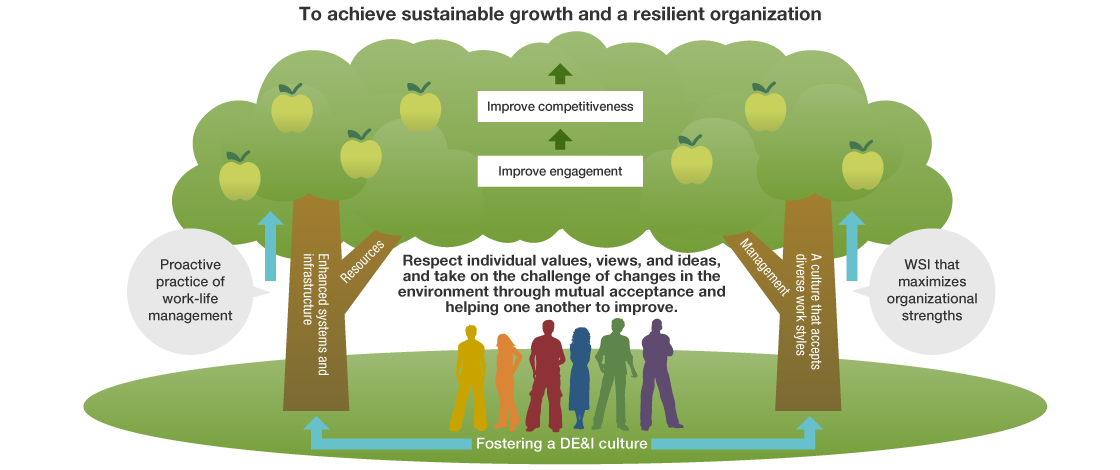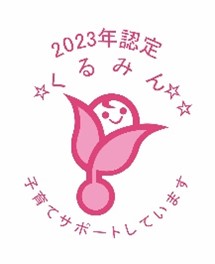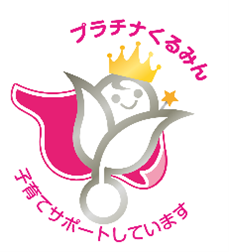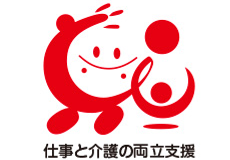Work-Life Management
1. Philosophy
At JSR, we think that fostering diversity, equity, and inclusion (DE&I) and the two pillars built on that are essential in improving the competitiveness of the organization and employees to achieve sustainable growth and a resilient organization. Those two pillars are 1) establishing a work environment, various systems, and IT infrastructure to make flexible work styles possible, and 2) work-style innovation (WSI) that maximizes results by accepting many flexible work styles at each workplace, mutually supporting them, and transforming them into organizational strengths.
To explain in more detail, employees use the various systems and infrastructure appropriately, as needed, proactively practice work-life management, and implement a workstyle that allows them to work in health and with vigor. Each workplace is aiming to realize the vision for their own division by employing business management, people management, and using team building to create psychological safety as they make active use of the latest digital technologies and other means to dramatically improve productivity.
Such environments increase employee engagement. Workplaces that make it easy to work and provide job satisfaction generate innovation and competitiveness. In turn, this will lead to sustained growth for individuals and organizations.

2. Advancement Structure
The Human Resources Development Department establishes work environments and formulates, designs, and
implements policies on various systems. The Diversity Development Office takes the lead on formulating
the policy on work style innovation and planning and implementing measures. Based on the medium-term
human resources strategy, the two organizations work closely together to report the details of
initiatives to management as needed and use the intranet to make employees aware of these
initiatives.
3. Systems for Supporting Flexible Work Styles
(1) Systems for Supporting Flexible Work Styles
JSR has a variety of support systems designed to create an environment that helps employees balance work and childcare, caregiving duties or treatment for an injury or illness. JSR also distributes a guidebook detailing the various work-life support programs (including those within and outside the company) available to employees of various backgrounds to educate employees about the options available to them.
We are implementing various initiatives to support employees’ diverse working styles. In addition to easing the requirements to qualify for the work-from-home system, this includes changing the system to eliminate uniform time limitations (up to 5 days per month) and allow for flexibility depending on the work or department; introducing a by-the-hour annual paid leave system that allows employees to take their annual paid leave in one-hour increments; extending the time period during which employees can work shortened hours for child care and nursing care; and adding more annual paid holidays for young employees (14 days in the first year of employment).
| FY2019 | FY2020 | FY2021 | FY2022 | FY2023 | ||
|---|---|---|---|---|---|---|
| Number of users | female | 14 | 15 | 21 | 13 | 16 |
| male | 61 | 59 | 101 | 87 | 74 | |
| Percentage of taking leave | female | 100% | 100% | 100% | 100% | 100% |
| male | 42.7% | 50.9% | 72.7% | 81.3% | 89.2% | |
| FY2019 | FY2020 | FY2021 | FY2022 | FY2023 | ||
|---|---|---|---|---|---|---|
| Percentage of returning to work | female | 100% | 100% | 100% | 100% | 100% |
| male | 100% | 100% | 100% | 100% | 100% | |
| Retention rate after one year* | female | 100% | 95% | 89% | 81% | 100% |
| male | 97% | 100% | 96% | 59% | 95% | |
| Retention rate after three years* | female | ー | 96% | 95% | 84% | 53% |
| male | ー | 98% | 92% | 64% | 70% | |
* Retention rate after one year: Of the number of employees who have returned from childcare leave in
fiscal year (n-1), the percentage who still work at the company at the end of fiscal year n
Retention rate after three years: Of the number of employees who have returned from childcare leave in
fiscal year (n-3), the percentage who still work at the company at the end of fiscal year n
| Life Stage | Available Support | Description |
|---|---|---|
| Prenatal (During fertility treatment, pregnancy etc.) | Shorter working hours | During pregnancy, employees may reduce their working hours up to two hours per day. Employees engaged in fertility treatments can reduce their working hours by up to four hours per day, or up to 44 hours per month. |
| Work from home | In cases where increased productivity is anticipated, employees can work from home based on a schedule where the work-from-home frequency or period is set individually, subject to approval by the department head. | |
| Before and after childbirth | Maternity leave (prenatal & postpartum)* | Employees can take maternity leave starting six weeks before, and extending eight weeks after childbirth. |
| Childcare leave system at the time of birth | Employees are able to take four weeks of leave within eight weeks of the birth of a child. | |
| Special paid paternity leave | Male employees can take four days of special paid paternity leave anytime from one week prior to two weeks after the birth of their child. | |
| Extended childcare leave* | Employees are able to take a leave of absence up to three times until their child turns 18 months of age. | |
| Extended childcare leave counseling | Upon request by employees taking extended childcare leave, counseling sessions between the employee and their supervisor are held. In these sessions they discuss and aim to resolve any worries or issues that could hinder a smooth transition back to working life. | |
| Balancing work and childcare | Shorter working hours | Employees with non-working spouses can shorten their working hours until the child is three years of age. Additionally, employees with working spouses can reduce their working times until the child is in their sixth year of elementary school. |
| Work from home | In cases where increased productivity is anticipated, employees can work from home based on a schedule where the work-from-home frequency or period is set individually, subject to approval by the department head. | |
| Family care leave | Employees can take up to ten days of leave in half-day units per year to provide nursing care for family members that live in the same household. Uses include, accompanying family members to the hospital, medical examinations, vaccinations etc. Can also be taken in one-hour increments. | |
| Balancing work and nursing care | Shorter working hours | Employees providing nursing care for family members can reduce their working hours by up to four hours per day, or up to 44 hours per month. |
| Work from home | In cases where increased productivity is anticipated, employees can work from home based on a schedule where the work-from-home frequency or period is set individually, subject to approval by the department head. | |
| Family care leave | Employees can take up to ten days of leave in half-day units per year to provide nursing care for family members that live in the same household. Uses include, accompanying family members to the hospital, medical examinations, vaccinations etc. Can also be taken in one-hour increments. | |
| Nursing care leave | Employees providing nursing care for family members can take up to 20 days of leave in
half-day units annually. Can also be taken in one-hour increments. |
|
| Extended nursing care leave* | Employees providing care for family members can take up to 24 months of extended nursing care
leave. Extended leave can be broken down into as many as three periods for up to two years. |
* At the request of employees who use these various systems, we have established the mechanisms for lending company PCs or making it possible for them to access email and internal systems through a dedicated app on their personal devices while on leave. In addition to providing a way for employees to obtain information on the company and workplace during leave, these mechanisms are used as BCP measures during natural disasters, pandemics, etc.
JSR has also established a discretionary work system for employees in R&D, as well as a "no-core" flextime work system for employees who do not work shifts. Employees who need time off for community service activities can take up to a total of five days paid leave per year as volunteer leave.
JSR acquired “Platinum Kurumin” certification and JSR Micro Kyushu “Kurumin” certification
In August 2007, April 2012, and October 2023, JSR received the Next Generation Mark accreditation (nicknamed "Kurumin") issued by the Minister of Health, Labor and Welfare. Kurumin designates enterprises that provide superb parenting support. JSR Micro Kyushu Co., Ltd. also received the mark in May 2017.
Furthermore, in October 2023, JSR acquired “Platinum Kurumin” certification, a special recognition given to leading companies supporting child-rearing with a higher level of initiatives.
This certification was received based on an evaluation of JSR’s target achievement in its action plan for FY2020 to FY2022 (action plan announced based on the Act on Advancement of Measures to Support Raising Next-Generation Children) and the various measures we implemented such as training. The action plan set a numerical target of increasing the percentage of male employees taking childcare leave to 30% or more, and in FY2022 we reached 81.3%. This figure is much higher than the national average of 17.1% for male employees taking childcare leave in FY2022. In addition, 100% of JSR's eligible female employees have taken childcare leave, and as a result of heightened awareness among both men and women of the need to balance work and childcare, taking childcare leave is becoming the norm. In addition to childcare-related initiatives, JSR was also recognized for the wide range of initiatives it has put in place to foster a corporate culture that encourages diverse and flexible work styles and career support, including training for key management personnel and dispatch of employees for external training.


JSR was awarded the "Tomonin" Mark for promoting the establishment of a work environment that enables employees to balance work and caregiving duties
JSR uses this mark (nicknamed Tomonin), which was created by the Ministry of Health, Labor and Welfare for promoting the establishment of workplace that enable employees to balance work and caregiving duties, to showcase initiatives in JSR and create an environment that enables employees to continue to contribute actively while balancing work and caregiving duties.

(2) JSR Original Support Benefits
In addition to compensation benefits available during paid leave periods via health and employment insurance, JSR employees are provided with the following original benefits. These benefits aim to aid employees in maintaining a healthy work-life balance.
- Childbirth Lump-Sum Allowance
Women enrolled in JSR's health insurance program are eligible to receive 100,000 yen per child as Childbirth Lump-Sum allowance in addition to the government mandated childbirth allowance. - Extended Childcare Leave Allowance
Employees on extended childcare leave are eligible to receive their base salary with an additional 50% bonus for the first five days. This allowance is funded via JSR Mutual Aid Association. - Post Childcare Leave Reinstatement Allowance
For employees who have returned back to work for a continues six months following maternity leave or extended childcare leave (of at least one month) are eligible to receive an allowance of 200,000 yen per child. This allowance is funded by JSR Mutual Aid Association for the purpose of recognizing employees past service, and continued dedication. - Daycare Allowance
In households where both parents work, employees are reimbursed half the cost of babysitter services that are required on working days. Costs are reimbursed via JSR Mutual Aid Association with an annual limit of 400,000 yen per eligible employee.
4. Work Style Innovation
JSR recognizes the need for continual innovation of work styles to turn organizational strengths into organizational results. Work style innovation does not just refer to continuing to search for better work styles by checking and reflecting on your own work styles. It includes innovation to achieve better work styles for the organization as a whole while learning about and understanding the diverse work styles adopted by those around you and mutually supporting one another from time to time. We think that, as individuals and the organization continue to innovate work styles, this will lead to a resilient organization that is able to respond flexibly to changes in the external environment.
FY2023 Topics
In FY2023, we implemented a new training program that was implemented to have key management personnel reflect on the way they work and think about what they need to/can do to realize their ideal way of working.
During the training, each participant was asked to think in advance about (1) whether they are
highly engaged and able to work in a way that is sustainable for both themselves and the
organization, (2) whether they are able to fulfill their responsibilities even if they have some
difficulties, and (3) whether they can produce a diverse workforce of managers. The participants
then took part in a group discussion on what they need to and can do in order to realize their
ideal way of working. In considering the gap between the ideal way of working and the current
situation of working as a manager, the participants learned about various unconscious biases, such
as their own preconceptions and assumptions, and became aware of the possibility of changing their
negative beliefs.
In the process of identifying issues related to work styles and management, the participants also
identified what they thought needed to be addressed in terms of the company's structure and
systems, in addition to what they could do themselves. The results were shared with the Diversity
Promotion Office and the Human Resource Development Department as a whole and discussed, leading
to a review of the actual working environment.
We will continue to advance initiatives that enable all employees, including general employees as well as managers, to become aware of what they can do themselves, to think about better ways of working, and to make concrete changes in their behavior.

5. JSR Workers’ Union
(1) Thinking on Workers’ Union Activities
We strive to maintain a relationship with JSR Workers’ Union that allows us to routinely engage in constructive dialogue through regular labor-management councils, meetings concerning the revision of labor agreements, and other opportunities. We are also working to build better workplace environments with attention to union concerns—namely, wage policy, labor environment policy, welfare policy, leisure time, public relations and volunteerism policy, and organizational policy.
(2) Codes of Conduct
We will abide by national and international labor codes and respect workers’ right of association and right for collective negotiation in the realm of basic labor rights.
(3) Communication between JSR and JSR Workers’ Union
JSR and JSR Workers’ Union have entered a labor agreement based on workers’ union regulations. As specified in the labor agreement, we notify JSR Worker’s Union before implementing significant changes in operations.
The president, directors in charge of individual business segments, and workers’ union representatives have regular discussions to exchange opinions and conduct Q&A sessions regarding the working environment, business conditions, major company policies, and workers’ union activities. JSR Workers’ Union discloses the content of these discussions with union members. Moreover, we endeavor to deepen mutual understanding and trust as well as to maintain and strengthen sound labor relations through frequent labor-management councils at the employee and plant levels, local labor-management councils, and Safety and Health Committee meetings.
In FY2022, we held a number of discussions on our approach to future employee welfare and benefits systems in order to address growing diversity in the lifestyles and careers of our employees. We are now making preparations involving labor and management aimed at realizing an employee welfare and benefits system that provides assistance and opportunities for employees to think and act on their own with regard to health improvement, life planning, career planning and skills building.
(4) Dialogue between the Workers’ Union and its Members
Union members at each workplace represent workplace workers' opinions. They also act as a conduit between union leadership and the union members. Workplace discussions and questionnaires are conducted to ensure the ideas and opinions of union members are incorporated into union activities.
(5) JSR Workers’ Union Membership
As of the end of March 2023, the enrollment rate in JSR Workers’ Union was 100%, made up of 1,653 employees excluding board members, management personnel, etc. The Union is a member of Japanese Federation of Chemical Workers’ Unions, an umbrella organization.
The total number of union members is 2,022, including members of unions organized at consolidated subsidiaries. This represents 25.3% of the 7,994 employees at the consolidated level.
| FY2018 | FY2019 | FY2020 | FY2021 | FY2022 | ||
|---|---|---|---|---|---|---|
| JSR Corporation | Number of members | 2,629 | 2,709 | 2,799 | 2,746 | 1,653 |
| Enrollment rate | 100% | 100% | 100% | 100% | 100% | |
| JSR Group | Number of members | 3,588 | 3,739 | 3,766 | 3,775 | 2,022 |
| Percentage of consolidated employees | 41.0% | 41.3% | 40.1% | 38.9% | 25.3% | |

